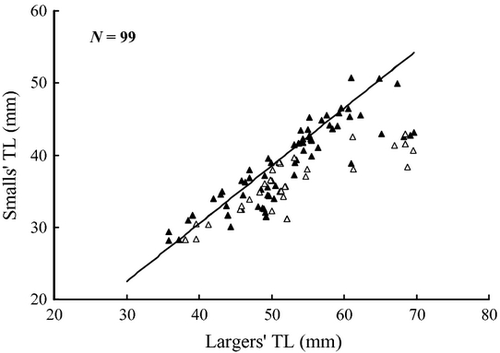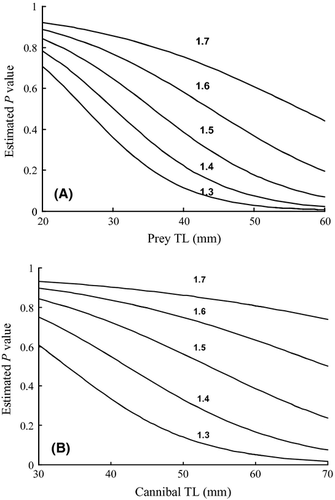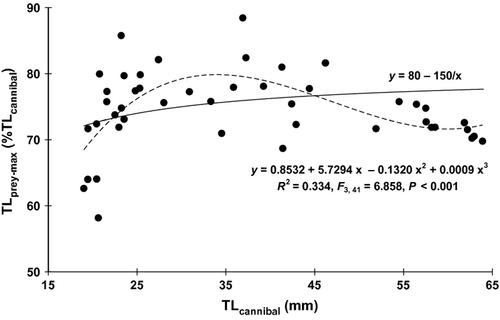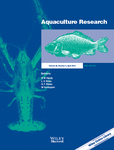Application of logistic regression analysis to predict cannibalism in orange-spotted grouper Epinephelus coioides (Hamilton) fry
Abstract
Cannibalism is frequently observed in larviculture of orange-spotted grouper Epinephelus coioides. Previously, based on measurements of morphometric characters, a linear equation of total length (TL) of prey to cannibals was proposed: TLprey = 0.80 TLcannibal – 1.50. To verify the reliability of the equation, experiments were performed with pairs of fish with different TLs. Cannibalism occurred only when the cannibal-prey size ratios were equal to or larger than that predicted by the equation. To predict the probability of cannibalism among the grouper of known TLs, a logistic regression model was proposed. The logistic regression model is:

Introduction
Cannibalism is defined as a process in which an individual kills and consumes the entire or most of another individual of its own species (Elgar & Crespi 1992). It has been widely observed to be far more common in fish than in terrestrial vertebrates (Dominey & Blumer 1984). The occurrence of cannibalism has been identified in at least 36 families of fish, some of which are economically valuable cultured species (Smith & Reay 1991; Hecht & Pienaar 1993). Compared with those in wild populations, reared fish have larger opportunities to meet cannibals and little or no chance of escaping predation via habitat segregation or migration (Baras & Jobling 2002). In addition, larval and juvenile fish have higher growth capacities than adults. Therefore, young generally consume large food rations relative to their body size and are prone to growth divergence, which may induce and enhance cannibalism (Baras & Jobling 2002).
Epinephelus groupers are economically important cultured finfish in Southeastern Asia, including Taiwan. After two decades of systematic research, propagation of at least four species has been established in Taiwan (Liao, Su & Chang 2001). Among them, orange-spotted grouper, Epinephelus coioides (Hamilton), is the most intensively cultured species. In larviculture of the grouper, intracohort cannibalism, i.e., cannibalism among the same year class, is observed from the larval stage, ca. 13–16 mm in total length (TL), but serious cannibalism is found after metamorphosis when the juveniles reach more than 25 mm in TL (Narisawa, Kohno & Fujita 1997; Hseu, Chang & Ting 2003). Elongated dorsal and ventral spines in grouper larvae before metamorphosis could be a major obstacle to larval cannibalism (Hseu et al. 2003). The cannibalistic fish usually seize their prey on the throat or trunk, and then consume them head first and horizontally (Hseu 2002). This behaviour corresponds to type II cannibalism described by Hecht and Appelbaum (1988). This type of cannibalism usually starts when size differences become significant and is ruled by gape size limitations (Hecht & Appelbaum 1988; Baras & Jobling 2002). A grouper can swallow a conspecific individual only when its mouth width (MW) exceeds the body depth (BD) of its prey. Accordingly, the cannibal's TL must be larger than the prey's (Hseu et al. 2003). Early size differences and rearing conditions that favour growth dispensation are thus thought to be the major cause of cannibalism (Fukuhara 1989; Doi, Munir, Nik Razali & Zulkifli 1991; Lim 1993; Watanabe, Ellis, Ellis, Lopez, Bass, Ginoza & Moriwake 1996; Liao et al. 2001; Hseu 2002; Hseu, Hwang & Ting 2002). So far, routine size grading is the most frequently used method to mitigate cannibalism in grouper larviculture and usually results in higher survival rates (Fukuhara 1989; Watanabe et al. 1996; Liao et al. 2001; Hseu 2004).

According to the equation, when the value of TLprey ranges from 20 to 50 mm, the theoretical minimum TLcannibal is approximately 1.29–1.34 times that of the TLprey (Hseu et al. 2003). However, using an indirect model gained from measurements of morphometric parameters could over- or under-estimate minimum TLs of cannibals and impact the grading effect (Brownell 1985; Hecht & Appelbaum 1988; Johnson & Post 1996; Baras 1999; Baras & Jobling 2002; Hseu, Hwang & Ting 2004; Hseu, Shen, Huang & Hwang 2007; Baras, Hafsaridewi, Slembrouck, Priyadi, Moreau, Pouyaud & Legendre 2010; Baras, Silva del Augila, Montalvan Naranojos, Dugué, Chu, Duponchelle, Renno, Garcia-Dávila & Nuñez 2011). Cannibals do not always eat prey as large as physically possible. In addition, prey size preferences of cannibals vary substantially between species and life stages (Brownell 1985; Hseu et al. 2007; Baras et al. 2010, 2011). Thus, more realistic estimates of the size ratios between cannibals and prey still are important for grouper, which grow fast and need frequent size-grading (Baras & Jobling 2002; Hseu 2004).
The objectives of this study were to test the validity of Eqn (1) to predict cannibalism by performing experiments using pairs of fish of different sizes (TLs) and thereafter to derive an equation to predict the probability of cannibalism occurring among grouper fry that differed in body size (TL).
Materials and methods
In the current work, a series of pairwise experiments were carried out to test the validity of the cannibalism equation [Eqn (1)] proposed by Hseu et al. (2003). The tests were carried out using one hundred and seven pairs of grouper fry which differed in TL ratios. Before the experiment, fish from large (35.8–69.7 mm)- and small (28.2–50.7 mm)-size groups were chosen and separated into individual nets. The size ratio ranged from 1.20 to 1.79. Both sizes of fish were starved for 1 day. When the experiment commenced, the two sizes of fish were anaesthetized with 400 μL/L of 2-phenoxyethanol and their TLs were carefully measured with a dial calliper to the nearest 0.05 mm. Each pair of fish was co-cultured in a glass aquarium (30 × 15 × 28 cm) containing 10 L of seawater for 24 h without feeding. After 24 h, we recorded whether the small fish had been consumed by the larger one. In cases where the small fish died but was not engulfed by the larger individual the result was excluded from further analysis. Death of the small fish due to unknown causes occurred in eight of the 107 tested pairs, leaving 99 pairs for analysis.
A logistic regression model, which is used to model dichotomous (0 or 1) outcomes, was derived to predict the cannibalistic probability under different TLprey and TLcannibal. In the model, the dependent variable was scored 1 and 0 when the cannibalism took place and not, respectively, in the 99 pairs of grouper fry with two independent variables of TLprey and TLcannibal. Significance of the coefficients in the model was determined with Wald chi-squared -test. The Hosmer–Lesmeshow test (Hosmer & Lemeshow 2000), which partitions the observations into 10 equal sized groups according to their predicted probabilities and follows a chi-squared distribution, was used to assess the goodness-of-fit of the logistic regression model. The software used for the statistical analyses was SPSS (Chicago, IL, USA) for Windows version 12.0, and all statistical tests were considered significant at P < 0.05.
Results
There were 30 cases of cannibalism in the 99 pairs of fry that were used in the analyses (Fig. 1), and cannibalism occurred only when the smaller of the two fish had a TL equal to or smaller than that predicted by the Eqn (1).


Discussion
The cannibal-prey length relationship determines the minimum TL of a cannibal which could swallow a prey (Johnson & Post 1996). In our pairwise experiments, all of the cannibalism occurred only when the cannibal had equal or larger size than that predicted by Eqn (1) (Fig. 1). Thus, the results of the pairwise experiments support the application of the threshold for grading orange-spotted grouper to reduce cannibalistic mortality. In a similar experiment carried out on giant grouper, Epinephelus lanceolatus (Bloch) the threshold value of TL difference for grading was also ca 30%, and cannibalism was observed in 36 out of 136 pairs of fish. Thus, results of the study conducted on giant grouper are similar to those found in the present study with orange-spotted grouper (Hseu et al. 2004).
Based on Eqn (2), we drew two estimated logistic curves for cannibalism in the orange-spotted grouper with different cannibal-prey length ratios against preys (Fig. 2A) and cannibals' TL (Fig. 2B). From the figs, it could be found that the probability of cannibalism in the early stages of orange-spotted grouper is higher than that in later stages. For example, if the ratio of TLcannibal/TLprey is fixed at 1.4, when the TLprey is 20 mm, the probability of cannibalism is 0.78; but when the prey increases to 40 mm in TL, the probability decreases to 0.22 (Fig. 2A). In contrast, if the cannibalism probability is fixed at 0.78 and the prey grows to 40 mm, the predicted TLcannibal is 68.75 mm and the ratio of TLcannibal/TLprey increases to 1.72. Actually, in laboratory and rearing experiences, cannibalism does decline or even disappear as grouper fry age. When the grouper grows up to 50–60 mm, intracohort cannibalism is not often observed (Hseu 2004).

Even if cannibalistic E. coioides can consume prey almost as large as physically possible, they rarely do so, and seemingly prefer much smaller prey (Fig. 2B). The prediction is the same with that estimated from giant grouper (Hseu et al. 2007). In fact, previous studies have shown that when a cannibal is offered prey of three sizes, orange-spotted grouper cannibals do prefer the smaller prey to the larger ones (Hseu 2006). Similar situations have been found in other cannibalistic fish such as yellow perch Perca flavescens Linnaeus (Post & Evans 1989), Arctic charr Salvelinus alpinus (Linnaeus)(Amundsen, Damsgård, Arnesen, Jobling & Jørgensen 1995), Atlantic cod Gadus morhua Linnaeus (Blom & Folkvord 1997), pike Esox lucius Linnaeus (Nilsson & Brönmark 1999), dorada Brycon moorei Steindachner (Baras, Ndao, Maxi, Jeandrain, Thomé, Vandewalle & Mélard 2000), Pangasius djambal Bleeker (Baras et al. 2010), and Amazonian catfish Pseudoplatystoma punctifer (Castelnau)(Baras et al. 2011). Size selection could be related to an optimal foraging strategy by orange-spotted and giant grouper (Hart 1997; Hseu 2006; Hseu et al. 2007). Fish prey have greater ability to avoid predation as they grow bigger and swim faster (Fessehaye, Kabir, Bovenhuis & Komen 2006). Although the grouper cannibal could get larger, energetically more profitable prey, the time taken to catch, manipulate and swallow a prey, i.e., handling time, may be a major consideration for cannibalism (Kislalioglu & Gibson 1976; Nilsson & Brönmark 1999). That is, cannibals of increasing size prefer increasingly smaller prey not only relative to their own size, but also relative to their predation capacities (Baras et al. 2011).
The results of the present study, based on predation experiments, indicate that cannibalism becomes decreasingly efficient in cannibals of increasing size (Fig. 2b), which contrasts with the morphological predictions [i.e., Eqn (1)] that the minimum cannibal-prey size ratios decrease with the size of the cannibal. The morphological predictions relied on the use of simple linear relationships describing size-dependent variations of mouth width and body depth. However, although the coefficient of determination of the curve is very high (0.99), we noticed that when the TL < 45 mm for E. coioides from the data points of Figure 1 in Hseu et al. (2003), MW reflected a sigmoid allometric increase. A mean value of TL for each MW and BD at 1 mm intervals was calculated using Hseu et al. (2003) original data, and when MWcannibal = BDprey−max in intervals of 1 mm, corresponding TLscannibal and TLsprey−max were plotted and fitted with a cubic equation (Fig. 3). The revised model clearly showed that the linearly predicted TLprey−max was mostly overestimated when the TLcannibal < 22.5 and >45.0 mm, and underestimated when the TLcannibal ranged from 22.5 to 45.0 mm. A similar phenomenon was found in the Amazonian catfish P. seudoplatystoma punctifer, which due to an allometric changes in body proportions when the fish standard length (SL) <50 mm, the highest percentage of the maximum prey size to cannibal size occurred at 8 mm SL of the cannibal and then decreased to a plateau when the cannibal >30 mm SL (Baras et al. 2011). Application of this linear regression equation [Eqn (1)] is a simple way to estimate the risk of cannibalism and the relationship between cannibal and prey sizes in aquaculture. However, it should be noted that cannibalism could be more frequent in early life stages due to allometric growth, and less frequent in later life stages due to the decreasing efficiency of cannibalism with fish size.

The patterns of prey size preference documented here were carried out in artificial aquaria just like those in other studies (e.g., Hseu et al. 2004; Baras et al. 2010, 2011). We must admit that this type of study presumably overestimates the true risk of cannibalism associated with the size ratios under culture conditions for several reasons: (a) due to a lack of food, the hunger stimulus of the cannibal is maximal, (b) the experimental environment is small and it is difficult for the prey to escape the cannibal, and (c) the cannibal has no choice regarding prey size, i.e., it could prefer a smaller or larger victim if they were present. However, the present study could help grouper farmers to estimate the risk of cannibalism under culture conditions where potential prey are numerous and cannot escape as was the case here.
In conclusion, the present study largely supports the morphometric predictions proposed by Hseu et al. (2003) for size-grading orange-spotted grouper (though as revised in Fig. 3). It also provides more detailed information about the penalties that could be incurred if the proposed criteria could not be followed, and how these penalties vary with fish size (Fig. 2).
Acknowledgments
The authors thank Dr Shinn-Lih Yeh of the Mariculture Research Center, Fisheries Research Institute and Dr Pung-Pung Hwang of the Institute of Cellular and Organismic Biology, Academia Sinica for their assistance and support in the study.




